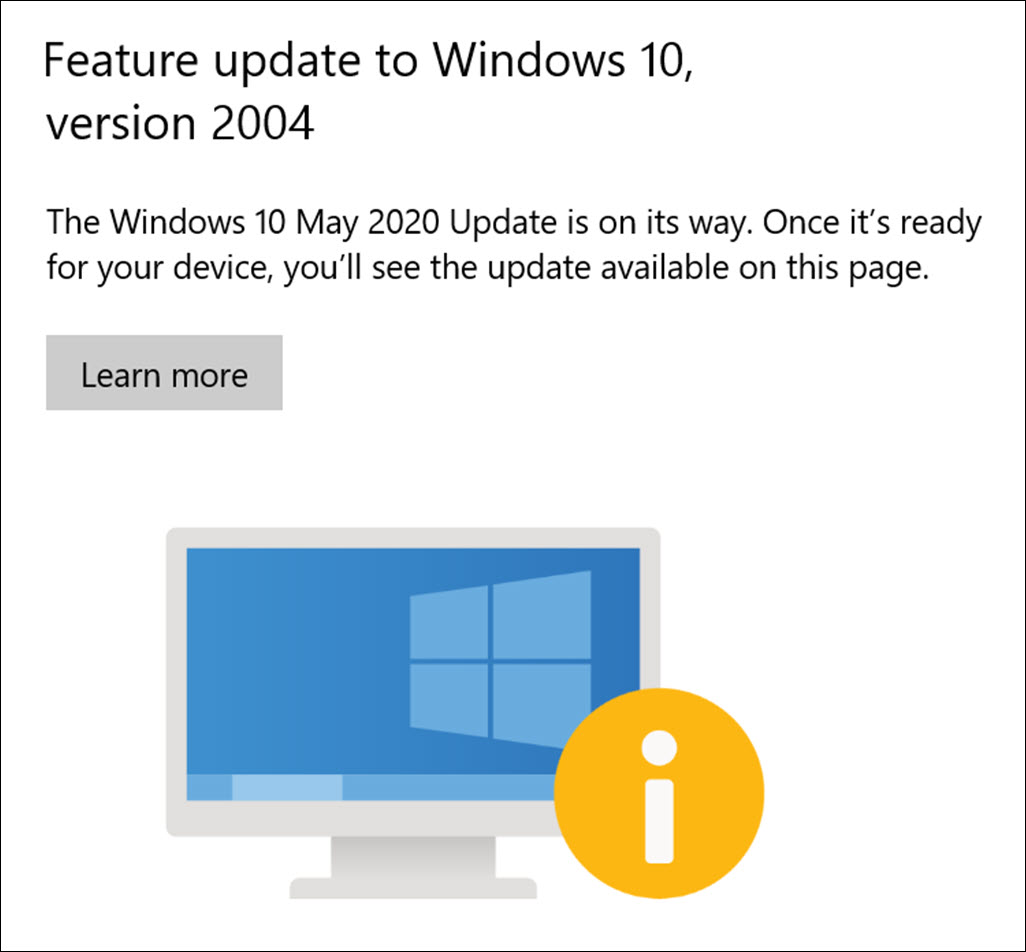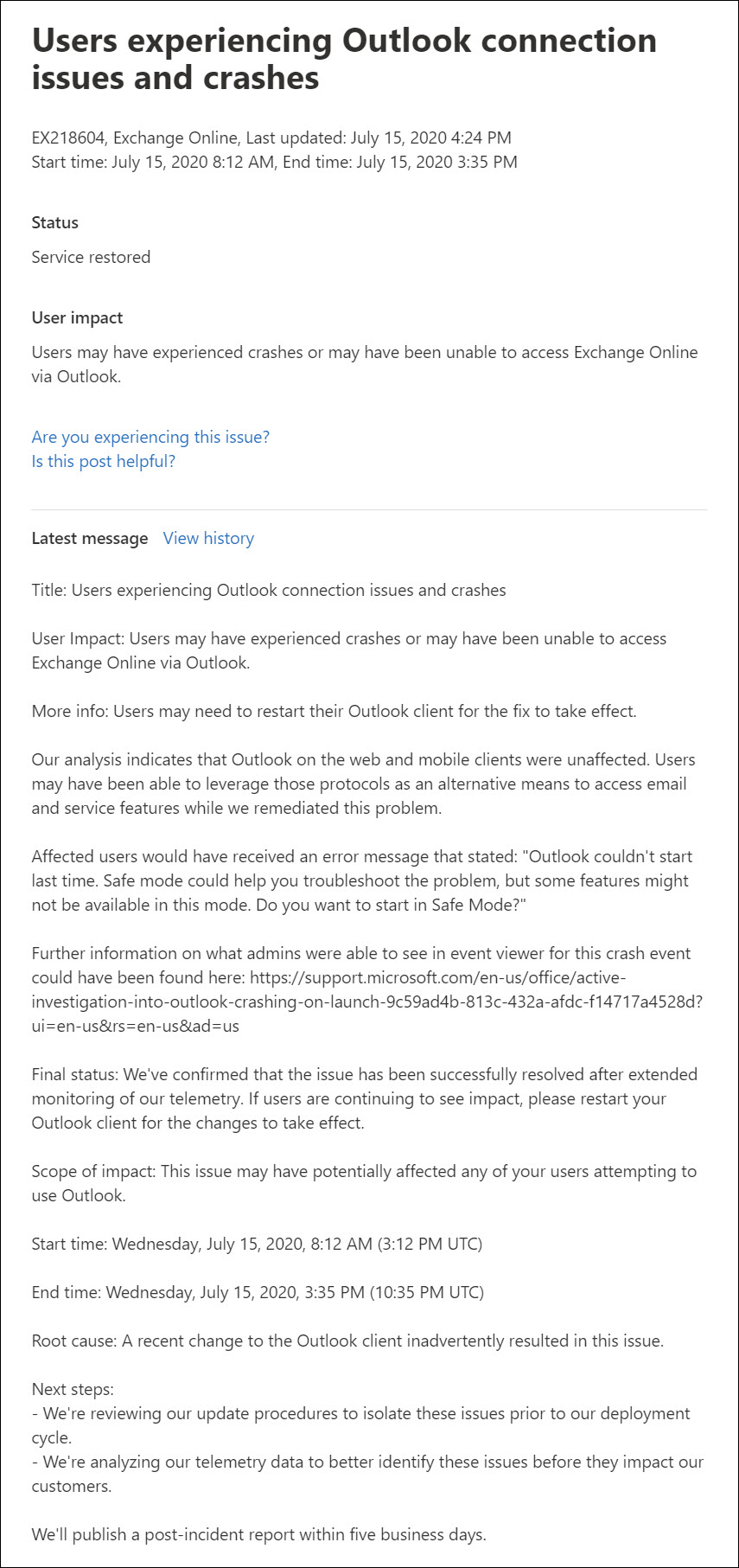
If you’re an Outlook user, there’s a good chance that the program crashed when you tried to start it yesterday (Wednesday, July 15, 2020).
Microsoft uses the word “Outlook” to describe many different things, so let’s be precise. This was a problem for people using (1) the Outlook desktop program, (2) installed with an Office 365 subscription license, (3) on a Windows PC, (4) connected to a business Office 365 mailbox (“Exchange Online”). It didn’t even affect everyone in that group; there’s no word yet about why Outlook crashed for some people but not others.
Still, that’s a lot of people that were affected worldwide – hundreds of thousands? Millions? And it hit mostly business users who depend on Outlook to get their work done. My phone was ringing off the hook in the morning. Twitter and Reddit were exploding with complaints. There were hours-long waits for Microsoft support.
Was it hackers? A Chinese cyberattack? An unexpected side effect of Covid 19?

Nope, nope, and nope.
Microsoft released an update on Tuesday night that broke its primary business email program all over the world.
It’s fixed now. While its support lines were melting, Microsoft engineers rushed a patch out the door. Apparently, there is a mechanism that allows them to push patches any time they choose (I have some questions about that), because Microsoft said the problem was resolved by 2:30pm PST. That matches what I heard from my clients.
Tonight, Microsoft’s explanation says only that “a recent change to the Outlook client inadvertently resulted in this issue.” We don’t know which update caused the problem. We don’t know why Microsoft didn’t discover this bug by, say, testing the update before it was released. (Microsoft’s support note is down below.)
Microsoft says that “we’re reviewing our update procedures to isolate these issues prior to our deployment cycle.” It says that “we’re analyzing our telemetry data to better identify these issues before they impact our customers.” Yes, I bet they are – incidents like this are beyond embarrassing.
It’s not the first time. We’ve been burned by Microsoft updates too often over the last ten or fifteen years. Two years ago, I described the many ways that Microsoft lost touch with consumers; one of Microsoft’s failures was the long string of updates that mucked up our computers.
“Windows updates I hate installing Windows updates. You hate installing Windows updates. Everybody hates installing Windows updates. Almost everyone has had the experience of seeing the dreaded message “Do not turn off your computer” and the endless swirling circle at the worst possible time. We trust updates on our mobile phones to go smoothly and not muck things up. We don’t trust Microsoft to update Windows without causing problems.”
The Windows operating system was introduced thirty-five years ago, Windows 10 is five years old, and Microsoft still can’t update Windows without breaking computers.

After embarrassing problems with most of the previous twice-yearly updates to Windows 10, an apparently humbled Microsoft began to limit the scope of the last couple of updates. The current release, which updates Windows to version number 2004, has virtually no new features. There is nothing to it. There is no reason for anyone running Windows to care if it is installed; it only exists because Microsoft has various enterprise support contracts tied to the twice-yearly schedule. It was tested for more than a year by Microsoft’s confusing and continually shifting beta program for IT shops and enthusiasts. It was released late as Microsoft pushed fixes until the last minute.
It’s broken! There is a long list of bugs that will cause problems on some computers if the May 2020 update is installed. If you see the above notice on your computer (Settings / Update & Security), you’re not getting it yet because Microsoft is blocking it for computers where it might muck things up.
Want an illustration of how broken the Windows update process is? The latest update for Windows, released almost two months ago, is blocked from installation on many of Microsoft’s own Surface laptops. Think about that: Microsoft’s latest operating system update breaks things on Microsoft’s own hardware!
Apple optimizes its software for its devices and computers. It just announced that it will start designing its own processors to optimize its hardware to match its operating system. Apple’s updates aren’t perfect, but . . .
Microsoft released a Windows update that has to be blocked from its own computers.
Windows is a jerry-rigged legacy operating system. Outlook is an outdated legacy business program. Microsoft prides itself on backward compatibility, so both Windows and the Office programs are loaded with outdated components that weigh them down but that Microsoft can’t bring itself to abandon.
We deserve better. Microsoft has the money and engineering prowess to do better. But Microsoft’s focus is on enterprise cloud services, not on declining PC sales and the relatively unprofitable problems of consumers and small businesses. Our experiences with Windows and Office will be getting messier and more frustrating, not less.

FOLLOWUP Thursday, July 16 10am PST: ComputerWorld has a report that makes sense. The crash may have been caused by a bad update on the server side, not an update to the Outlook program. That’s why Microsoft was able to fix it so quickly – it didn’t require a patch to be rolled out to every copy of Outlook. That makes it worse, not better. Here’s their description:
“Bottom line: Somebody at Microsoft changed something on a server, without testing the change, and it brought down Windows-based Outlook everywhere.
“Deployment “cycle”? Puh-leeze. We saw the same stupidity with the Windows Search box bug back in February. Somebody threw a monkey wrench (er, spanner) in the server. Everybody got clobbered.”

